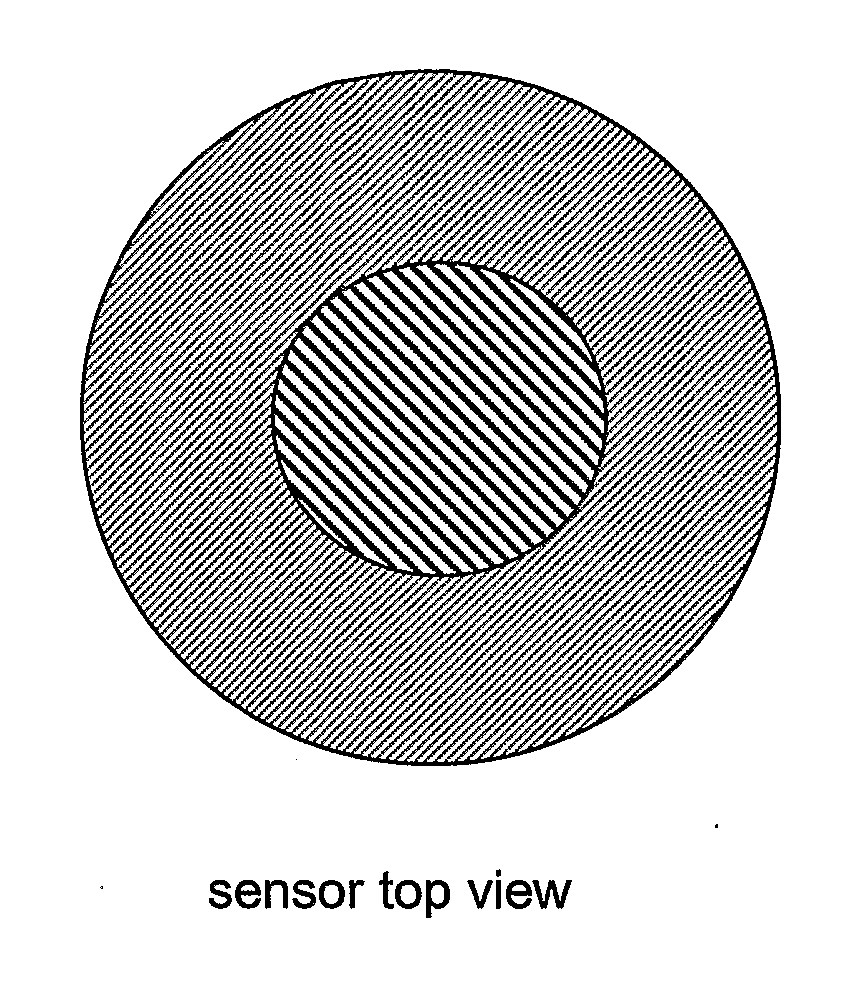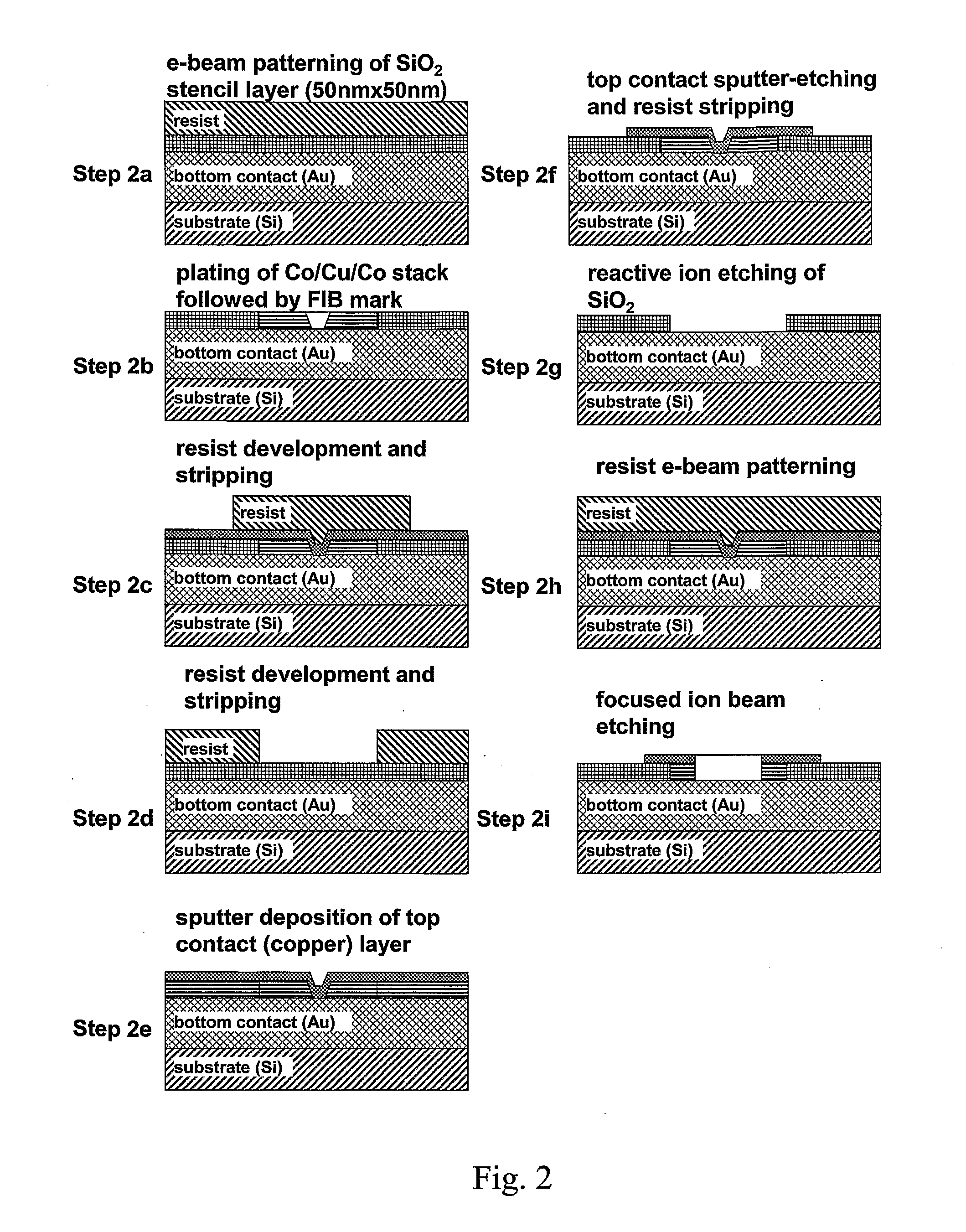Nanomagnetic detector array for biomolecular recognition
a biomolecular recognition and detector array technology, applied in the field of biomolecular sensor systems, can solve the problems of limited scanning speed and spatial resolution, prone to significant detection errors, and speed and accuracy remain major challenges
- Summary
- Abstract
- Description
- Claims
- Application Information
AI Technical Summary
Benefits of technology
Problems solved by technology
Method used
Image
Examples
example 1
Direct, mRNA Assay
[0091]mRNA is isolated from a thyroid biopsy specimen, fragmented, and conjugated to superparamagnetic nanoparticles bearing short oligonucleotide linkers using RNA ligase. Less than 20% of the particles bear more than one linker, so that most mRNA molecules are the only ones on their particles. The nanoparticle-mRNA conjugates are exposed to an array of GMR sensors of which the majority bear a single LNA (locked nucleic acid) probe directed to target sequences potentially found in the mRNA. After hybridization, a magnetic field is used to remove un-conjugated and mis-hybridized particles, bound particles are detected, and a stronger field is used to remove correctly-hybridized particles. Particles are again detected, and hybridization which resists the lower field but not the stronger field is interpreted as evidence of the presence of specific mRNA sequences. The presence and absence of specific sequences is used to diagnose the patient's condition.
example 2
Tethered Particle Assay
[0092]An array of GMR sensors, of which the majority bear a single gold-thiol-bound thiolated DNA oligonucleotide, is exposed to soluble oligodeoxynucleotides which can hybridize with those on the sensor, each of which is attached to a superparamagnetic nanoparticle by avidin-biotin chemistry, to give an array of nanoparticle-bearing, largely double-stranded DNA strands on the GMR sensor array. The GMR signal from each sensor is recorded, optionally in the presence of a magnetic field or field gradient. A sample containing transcription factors potentially capable of binding to some of the double-stranded DNA constructs is added, and the GMR signals are again recorded, optionally in the presence of a magnetic field or field gradient. Changes in the GMR signals associated with some DNA sequences are interpreted as evidence of the presence of transcription factors capable of binding to those sequences.
example 3
Tethered Particle—Alter Tether
[0093]A set of oligodeoxynucleotides whose sequences each include 8 copies of a particular 23-nucleotide sequence are immobilized by spotting onto an array of nanomagnetic sensors. Each oligo is spotted onto 50 sensors, on average, and sensors bearing oligonucleotides carry an average of 1.05 oligonucleotides. Avidin-conjugated nanomagnetic particles are washed over the array and allowed to couple to biotin molecules on the distal end of the oligonucleotides. The output of each nanomagnetic sensor is repeatedly monitored, and its average strength, as well as statistical measures of its variability and autocorrelation are recorded.
[0094]A sample containing microRNAs complementary to some of the oligonucleotide repeat sequences is incubated with the array, while an oscillating magnetic field gradient is applied to promote mass transfer. The array is washed, and the strength, variability and autocorrelation of the GMR sensors' output signals are again reco...
PUM
| Property | Measurement | Unit |
|---|---|---|
| height | aaaaa | aaaaa |
| height | aaaaa | aaaaa |
| outer diameter | aaaaa | aaaaa |
Abstract
Description
Claims
Application Information
 Login to View More
Login to View More - R&D
- Intellectual Property
- Life Sciences
- Materials
- Tech Scout
- Unparalleled Data Quality
- Higher Quality Content
- 60% Fewer Hallucinations
Browse by: Latest US Patents, China's latest patents, Technical Efficacy Thesaurus, Application Domain, Technology Topic, Popular Technical Reports.
© 2025 PatSnap. All rights reserved.Legal|Privacy policy|Modern Slavery Act Transparency Statement|Sitemap|About US| Contact US: help@patsnap.com



